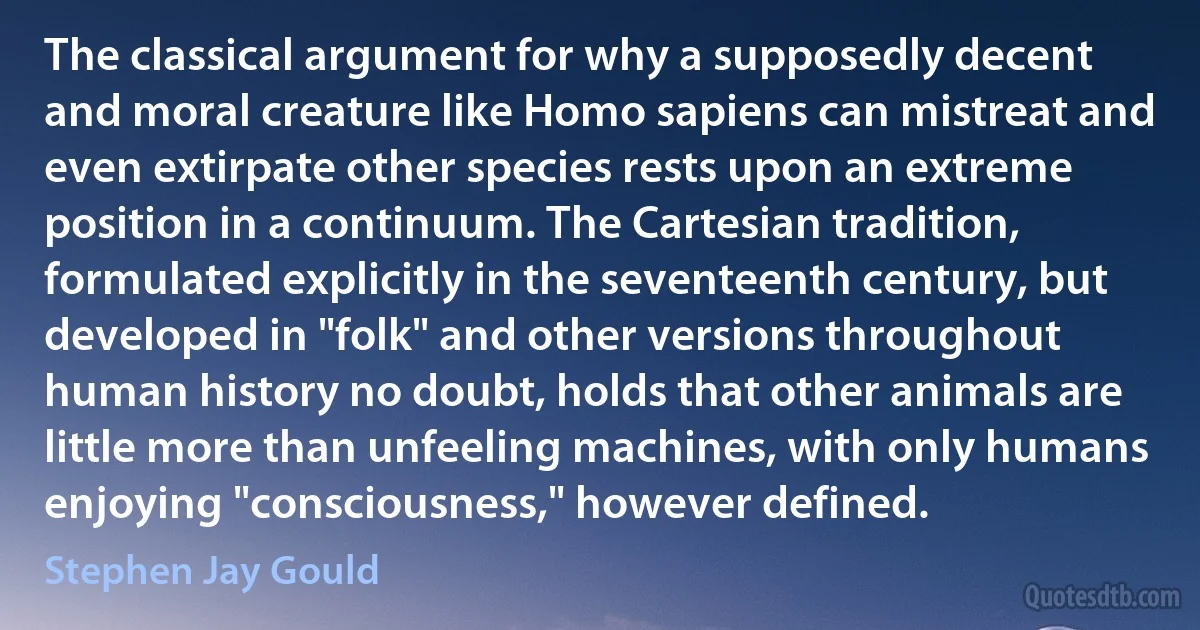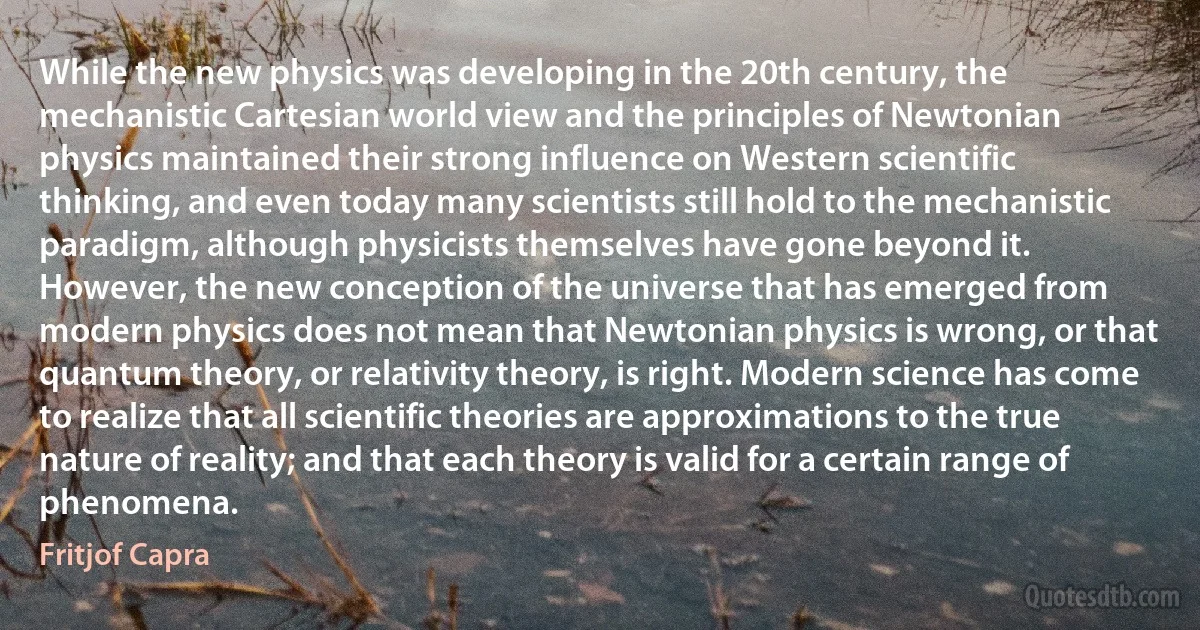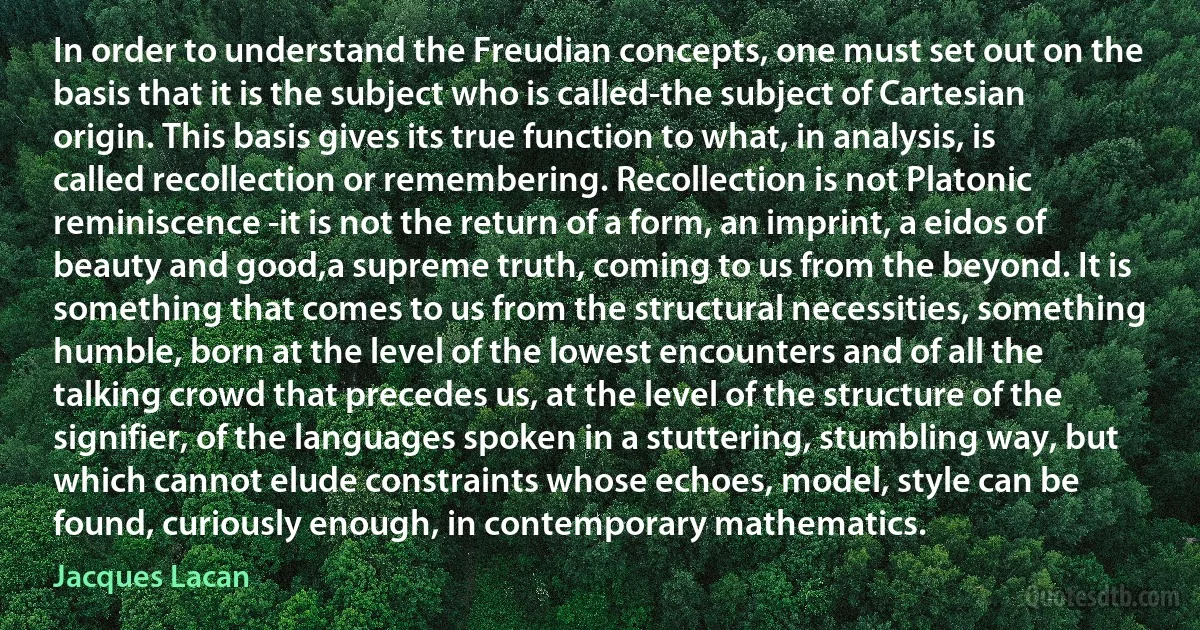Cartesian Quotes
The authority of science promotes and encourages the activity of observing, comparing, measuring and ordering the physical characteristics of human bodies. Cartesian epistemology and classical ideals produced forms of rationality, scientificity and objectivity that, though efficacious in the quest for truth and knowledge, prohibited the intelligibility and legitimacy of black equality. In fact, to "think" such an idea was to be deemed irrational, barbaric or mad.

Cornel West
[Though computer science is a fairly new discipline, it is predominantly based on the Cartesian world view. As Edsgar W. Dijkstra has pointed out] A scientific discipline emerges with the - usually rather slow! - discovery of which aspects can be meaningfully 'studied in isolation for the sake of their own consistency.

Edsger W. Dijkstra
That Descartes' Cartesian way of looking at animals, like they're machines... It is outdated, and quite frankly, 100% insane. Because, if we all understand that animals use their eyes to see, ears to hear, noses to smell, mouths to eat, legs to walk, feathers to fly, fins to swim, genitalia to procreate, bowels to defecate.. I'm always perplexed that most people don't believe that they can also use their brains to think, feel, be rational, be aware and be self-aware! Am I supposed to believe, that every body part of an animal functions just like it's supposed to, except the brain?

Gary Yourofsky
The Americans' "open-mindedness", which is sometimes cited in their favor, is the other side of their interior formlessness. The same goes for their "individualism". Individualism and personality are not the same: the one belongs to the formless world of quantity, the other to the world of quality and hierarchy. The Americans are the living refutation of the Cartesian axiom, "I think, therefore I am": Americans do not think, yet they are. The American "mind", puerile and primitive, lacks characteristic form and is therefore open to every kind of standardization.

Julius Evola
A dictum [Beckett] quotes from his favourite philosopher, the second-generation Cartesian Arnold Geulincx (1624-1669) suggests his overall stance toward the political: ubi nihil vales, ibi nihil velis, which may be glossed: Don't invest hope or longing in an arena where you have no power.

J. M. Coetzee
Neophil: ...Leibniz, Wolff, and their various successors, to what a level of perfection and completeness they have brought philosophy! How proud Germany can be of them! Yet what does it help to claim more for oneself than is right? Let us always acknowledge that someone other than a German, I add further, someone other than a Christian, namely, Spinoza, has participated immensely in the work of bettering philosophy. Before the transition from the Cartesian to the Leibnizian philosophy could occur, it was necessary for someone to take the plunge into the monstrous abyss lying between them. This unhappy lot fell to Spinoza. How his fate is to be pitied! He was a sacrifice for the human intellect, but one that deserves to be decorated with flowers. Without him, philosophy would never have been able to extend its borders so far.

Baruch Spinoza
And how does the God's existence emerge from the proof? Does it follow straightway, without any breach of continuity? Or have we not here an analogy to the behavior of the little Cartesian dolls? As soon as I let go of the doll it stands on its head. As soon as I let it go – I must therefore let it go. So also with the proof. As long as I keep my hold on the proof, i. e., continue to demonstrate, the existence does not come out, if for no other reason than that I am engaged in proving it; but when I let the proof go, the existence is there. But this act of letting go is surely also something; it is indeed a contribution of mine. Must not this also be taken into the account, this little moment, brief as it may be – it need not be long, for it is a leap. However brief this moment, if only an instantaneous now, this "now" must be included in the reckoning.

Søren Kierkegaard
In biology the Cartesian view of living organisms as machines, constructed from separate parts, still provides the dominant conceptual framework. Although Descartes' simple mechanistic biology could not be carried very far and had to be modified considerably during the subsequent three hundred years, the belief that all aspects of living organisms can be understood by reducing them to their smallest constituents, and by studying the mechanisms through which these interact, lies at the very basis of most contemporary biological thinking. This passage from a current textbook on modern biology is a clear expression of the reductionist credo: 'One of the acid tests of understanding an object is the ability to put it together from its component parts. Ultimately, molecular biologists will attempt to subject their understanding of cell structure and function to this sort of test by trying to synthesize a cell.

Fritjof Capra
Despite these shortcomings, the insights into the organization of grammar that were achieved in Cartesian linguistics remain quite impressive, and a careful study of this work can hardly fail to prove rewarding to a linguist who approaches it without prejudice or preconceptions as to the a priori limitations on permitted linguistic investigation.

Noam Chomsky
Menæchmus, a pupil of Eudoxus, and a contemporary of Plato, found the two mean proportionals by means of conic sections, in two ways, (α) by the intersection of two parabolas, the equations of which in Cartesian co-ordinates would be x2=ay, y2=bx, and (β) by the intersection of a parabola and a rectangular hyperbola, the corresponding equations being x2=ay, and xy=ab respectively. It would appear that it was in the effort to solve this problem that Menæchmus discovered the conic sections, which are called, in an epigram by Eratosthenes, "the triads of Menæchmus."

Thomas Little Heath
A person functioning exclusively in the Cartesian mode may be free from manifest symptoms but cannot be considered mentally healthy. Such individuals typically lead ego-centred, competitive, goal-oriented lives. Overpreoccupied with their past and their future, they tend to have a limited awarenessof the present and thus a limited ability to derive satisfaction from ordinary activities in everyday life. They concentrate on manipulating the external world and measure their living standard by the quantity of material possessions, while they become ever more alienated from their inner world and unable to appreciate the process of life. For people whose existence is dominated by this mode of experience no level of wealth, power, or fame will bring genuine satisfaction.

Fritjof Capra



